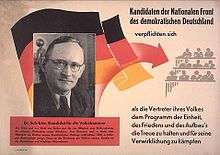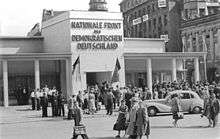National Front (East Germany)

The National Front of the German Democratic Republic (German: Nationale Front der Deutschen Demokratischen Republik, NF) until 1973 the National Front of Democratic Germany German: Nationale Front des Demokratischen Deutschlands) was an alliance (Popular Front) of political parties and mass organisations in East Germany (also known as a Blockpartei). The NF was controlled by the Socialist Unity Party of Germany and was formed to stand in elections to the East German parliament, the Volkskammer ("People's Chamber").
Constituent parties
- Socialist Unity Party of Germany (Sozialistische Einheitspartei Deutschlands: SED)
- Christian Democratic Union (Christlich-Demokratische Union: CDU)
- Liberal Democratic Party of Germany (Liberal-Demokratische Partei Deutschlands: LDPD)
- Democratic Farmers' Party of Germany (Demokratische Bauernpartei Deutschlands: DBD)
- National Democratic Party of Germany (National-Demokratische Partei Deutschlands: NDPD)
(all existing parties until 7 October 1989)
Constituent mass organisations
- Mass organisations with representatives in the People's Chamber of the GDR
- Free German Trade Union Federation (Freier Deutscher Gewerkschaftsbund; FDGB)
- Free German Youth (Freie Deutsche Jugend; FDJ)
- Democratic Women's League of Germany (Demokratischer Frauenbund Deutschlands: DFD)
- Cultural Association of the DDR (Kulturbund)
- Peasants Mutual Aid Association (Vereinigung der gegenseitigen Bauernhilfe, VdgB)
- Other organisations and associations
- Society for German–Soviet Friendship (Gesellschaft für Deutsch-Sowjetische Freundschaft, DSF)
- Committee of Antifascist Resistance Fighters (Komitee der Antifaschistischen Widerstandskämpfer, KdAW)
- People's Solidarity (Volkssolidarität, VS)
- Gesellschaft für Sport und Technik (GST)
- Ernst Thälmann Pioneer Organisation (Pionierorganisation „Ernst Thälmann“, TP)
- Writers' Association of the GDR (Schriftstellerverband der DDR)
- Domowina (league of Sorbs)
History

The National Front was the successor to the Demokratischer Block which had been founded in the Soviet occupation zone. The Front itself was founded on March 30, 1950. It operated through the issuing of a generally consistent proportion of seats (divided between the Front's parties and SED-controlled mass organisations) submitted in the form of a single list of candidates during each election to the People's Chamber. Seats were awarded on the basis of a set quota rather than vote totals.[1] As voters only had the option of approving or rejecting the list in far-from-secret conditions, it "won" with virtually unanimous levels of support.[2]
Although nominally a broad-based coalition of parties, in practice the SED was the only one with any real power. By ensuring that Communists dominated the lists, the SED essentially predetermined the composition of the People's Chamber.
In 1950-1951, the public rejection of the validity of the list by some German politicians resulted in some of them being imprisoned for "rejecting the electoral law of the German Democratic Republic" (as in the case of LDPD leader Günter Stempel). Although the SED had already become a full-fledged Stalinist "party of the new type" by the formation of the GDR, the other parties did not completely bend to the SED's will for a time. By the mid-1950s, however, the more courageous members of the constituent parties had been pushed out, and the parties had all been transformed into loyal partners of the SED. By this time, the SED itself had purged its few independent-minded members as well. The Front now took on a character similar to other groupings in the Eastern Bloc. For the next three decades, the minor parties in the Front had to accept the SED's "leading role" as a condition of their continued existence.
On December 1, 1989, the Front was effectively rendered impotent when the Volkskammer deleted the provision of the Constitution of East Germany that gave the SED a monopoly of power. Four days later, the Christian Democratic Union and Liberal Democratic Party, having thrown out their pro-Communist leaderships, withdrew from the Front. On December 16 the SED, having transformed itself into a democratic socialist party, reformed itself into the Party of Democratic Socialism. On February 20, 1990, an amendment to the constitution removed mention of the Front.[3]
Chairmen of the National Front
- Prof. Erich Correns (1950–1981)
- Prof. Lothar Kolditz (1981–1989)
See also
- Politics of East Germany
- List of Volkskammer members (9th election period)
- United Front (PRC) for a currently running system similar to the National Front of the DDR.
- Vietnamese Fatherland Front
References
- ↑ Eugene Register-Guard October 29, 1989. p. 5A.
- ↑ Kurt Sontheimer & Wilhelm Bleek. The Government and Politics of East Germany. New York: St. Martin's Press. 1975. p. 66.
- ↑ Peter E. Quint. The Imperfect Union: Constitutional Structures of German Unification. Princeton, N.J.: Princeton University Press. 1997. p. 37.